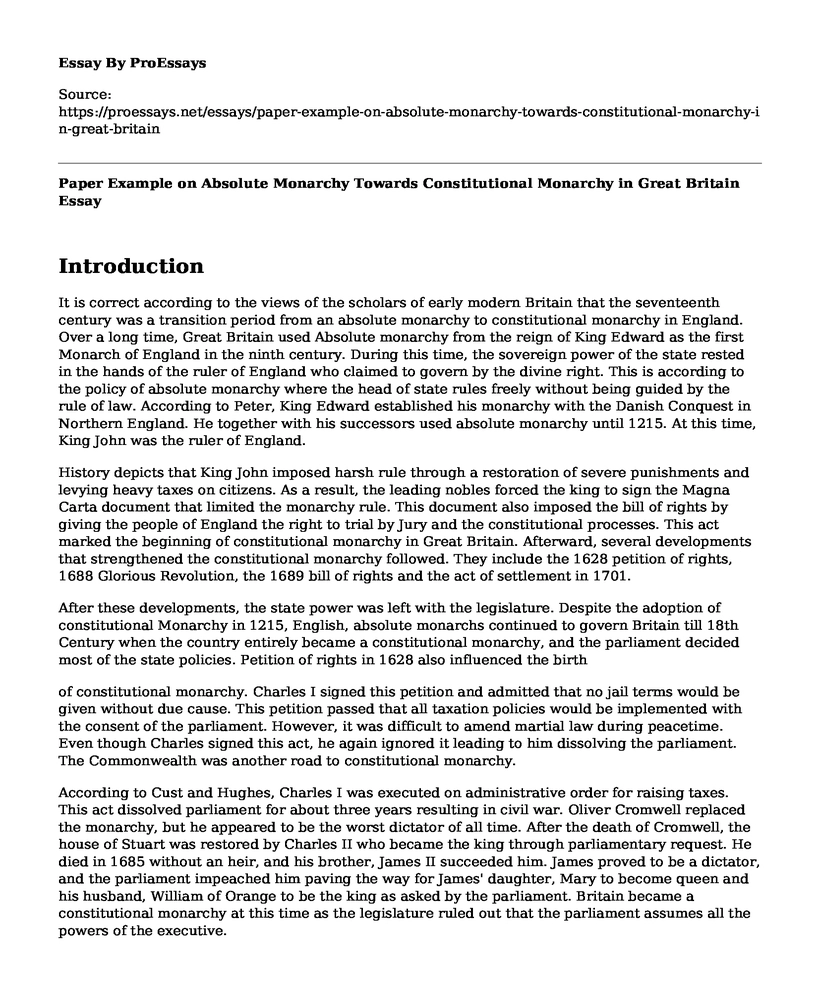Introduction
It is correct according to the views of the scholars of early modern Britain that the seventeenth century was a transition period from an absolute monarchy to constitutional monarchy in England. Over a long time, Great Britain used Absolute monarchy from the reign of King Edward as the first Monarch of England in the ninth century. During this time, the sovereign power of the state rested in the hands of the ruler of England who claimed to govern by the divine right. This is according to the policy of absolute monarchy where the head of state rules freely without being guided by the rule of law. According to Peter, King Edward established his monarchy with the Danish Conquest in Northern England. He together with his successors used absolute monarchy until 1215. At this time, King John was the ruler of England.
History depicts that King John imposed harsh rule through a restoration of severe punishments and levying heavy taxes on citizens. As a result, the leading nobles forced the king to sign the Magna Carta document that limited the monarchy rule. This document also imposed the bill of rights by giving the people of England the right to trial by Jury and the constitutional processes. This act marked the beginning of constitutional monarchy in Great Britain. Afterward, several developments that strengthened the constitutional monarchy followed. They include the 1628 petition of rights, 1688 Glorious Revolution, the 1689 bill of rights and the act of settlement in 1701.
After these developments, the state power was left with the legislature. Despite the adoption of constitutional Monarchy in 1215, English, absolute monarchs continued to govern Britain till 18th Century when the country entirely became a constitutional monarchy, and the parliament decided most of the state policies. Petition of rights in 1628 also influenced the birth
of constitutional monarchy. Charles I signed this petition and admitted that no jail terms would be given without due cause. This petition passed that all taxation policies would be implemented with the consent of the parliament. However, it was difficult to amend martial law during peacetime. Even though Charles signed this act, he again ignored it leading to him dissolving the parliament. The Commonwealth was another road to constitutional monarchy.
According to Cust and Hughes, Charles I was executed on administrative order for raising taxes. This act dissolved parliament for about three years resulting in civil war. Oliver Cromwell replaced the monarchy, but he appeared to be the worst dictator of all time. After the death of Cromwell, the house of Stuart was restored by Charles II who became the king through parliamentary request. He died in 1685 without an heir, and his brother, James II succeeded him. James proved to be a dictator, and the parliament impeached him paving the way for James' daughter, Mary to become queen and his husband, William of Orange to be the king as asked by the parliament. Britain became a constitutional monarchy at this time as the legislature ruled out that the parliament assumes all the powers of the executive.
The final step of Britain's transition from absolute monarchy to constitutional monarchy occurred in 1721 under George I when one member of parliament, Robert Walpole, became the government head in the office of the First Lord of the Treasury currently known as ''prime minister.'' The act of parliament of 1701 also contributed to this transition. It was formed to secure the Protestant succession to the throne and to reinforce the parliamentary system. The act also gave conditions for wearing the crown. The sovereign power also had the mandate to maintain the Church of England. In other words, this act addressed the religious and dynastic elements of succession as well as restricting the powers of the crown.
Conclusion
Overall, England has had both absolute and constitutional monarchy. The transition has occurred as a result of numerous events and factors. Currently, Britain has a constitutional monarchy where the powers of the king lie with the constitution. Therefore, the views of the scholars of early modern Britain are right when they point out the seventeen century was a period of transition from Absolute monarchy to constitutional monarchy in England. The rule of law governs a government with the constitutional monarchy as opposed to absolute monarchy. It implies that the constitution limits the powers of the ruler because it employs a parliamentary system.
Bibliography
Bucholz, Robert, and Newton Key. Early modern England 1485-1714: A narrative history. New York: John Wiley & Sons, 2009.
Cust, Richard, and Ann Hughes. Conflict in Early Stuart England: studies in religion and politics. Abingdon: Routledge, 2014.
Foster, Elizabeth Read. "Petitions and the Petition of Right." Journal of British Studies 14, no. 1 (1974): 21-45.
Gaunt, Peter. "Drafting the Instrument of Government, 1653-54: a reappraisal." Parliamentary History, 1989: 28-42.
Cite this page
Paper Example on Absolute Monarchy Towards Constitutional Monarchy in Great Britain. (2022, Jul 08). Retrieved from https://proessays.net/essays/paper-example-on-absolute-monarchy-towards-constitutional-monarchy-in-great-britain
If you are the original author of this essay and no longer wish to have it published on the ProEssays website, please click below to request its removal:
- Essay Sample on Modern Bureaucracy: A Systematic Organization of Governments
- Essay Example on Investing in Canada as a US National: Gov't Policies, Culture & Inflation
- Americans Failed to Remain United: 19th Century Constitutional Amendments - Essay Sample
- Essay Example on US Budget: Allocating Resources to Take Care of People's Needs
- Police Officer Guidelines - Report Example
- Essay Sample on Law Explanation: The Fourth Amendment of the US Constitution
- Essay on Nursing Leadership in Times of Crisis: Demonstrating Governance Skills Amidst the Pandemic







